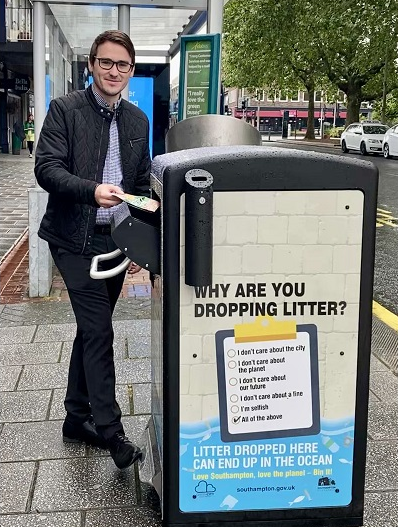Solar powered 'Bigbelly' compactor litter bins rolled out across the city
The new solar power compactor bins have display panels featuring our eye-catching new anti-littering campaign artwork
Southampton City Council has installed 25 solar powered compactor public litter bins as a pilot scheme, alongside other measures, to try and tackle the issue of litter in the city.
 The company that supply the units, Egbert H Taylor Co. Ltd, fitted the new bins at key locations around the city, where bins get full very quickly or are in an isolated area and can get full before they're scheduled to be emptied.
The company that supply the units, Egbert H Taylor Co. Ltd, fitted the new bins at key locations around the city, where bins get full very quickly or are in an isolated area and can get full before they're scheduled to be emptied.
The bins are enclosed units, containing sensors which activate a compactor mechanism to crush the waste when needed, maximising the capacity of the units and minimising the number of collections that need to be made. The 'Bigbelly' bins also contain smart technology that informs the depot when they're full and need emptying. This further reduces the number of collections being made, vehicles on the road and miles being driven. Operatives who currently collect waste from litter bins will have their time freed up to focus on other street cleansing duties.
As the units are enclosed, the waste is completely contained and can't escape from the bin when full, keeping wind-blown litter off the streets. Rodents and other scavengers are not able to get in to the bin to eat leftover food scraps, making cleaner, safer public spaces.
The new solar power compactor bins have display panels featuring our eye-catching new anti-littering campaign artwork which encourages residents to show their love for Southampton and the environment by disposing of litter properly. The display panels on the sides of the units are available for advertisers to secure, creating a valuable income stream for the council. Any business interested in advertising should contact: Advertising@Southampton.gov.uk
Other Local Authorities that have already adopted the compactor units have found them to be highly effective at reducing litter on the streets. After the pilot is complete, a further city wide roll-out will be considered.
Collections from the new compactor bins will be made by our existing 7.5t hybrid refuse vehicle, which further benefits the environment as it removes the requirement to line the bins with black sacks. The development team working on the new collection schedules are also planning where new recycling bins will be located to capture even more recyclable waste.
There are many benefits for the environment and the city by utilising the innovative technology in these bins, providing a more efficient and sustainable way of working.
Leader of Southampton City Council, Councillor Christopher Hammond, pictured, said: “We’re working to make our city greener, fairer and healthier. Our investment in these new hi-tech solar bins enable us to take five times more rubbish than our standard bins and to know digitally when it needs to be emptied. This is more efficient, saves time, keeps our streets cleaner and reduces pollution which endangers wildlife.
"Installing these new solar bins is just one part of the Green City Plan, to ensure that we’re a carbon neutral council by 2030 and that we’re all living in a greener city."
Councillor Steve Leggett, Cabinet Member for Green City & Place, said: “Investment in our waste services is essential to ensure we minimise damage caused to our natural environment. Installing these new solar bins is just one step to helping us all to ensure we are doing our bit to prevent rubbish cluttering our streets and possibly endangering our natural wildlife.
“We recently set ambitious, challenging goals to help tackle climate change in our Green City Plan, which demonstrates that the council wants to achieve more. It details the approach and principles that will ensure that the environment is at the forefront of all decision making.
“We are committed to reducing waste and making the most of our resources. We have set outcomes we want to achieve in the next 10 years and have over 60 activities planned over the first three years.”

